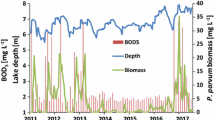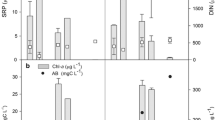Abstract
The SCENTO-System was used to study the carbon dynamics between phytoplankton primary production and heterotrophic bacterial secondary production. Most of the methods used nowadays in situ for limnological synecology studies were applied. Primary production measurement showed an increasing tendency with increasing content of chlorophylla. It provided a true photosynthetic rate lying within the range of eutrophic lakes. Net EOC released from the algae ranged from 8.5 to 27.5 μg C l−1(6h)−1. Accompanying the algal products the number of bacteria increased from 1.475 ×109 to 8.074×109 cells l−1. The bacterial mean cell volume was small, between 0.0315 and 0.0548μm3. Bacterial carbon production from direct growth estimates was compared with independent calculations of bacterial growth from EOC uptake and3H-thymidine incorporation. Direct estimates were 2.97–10.0 μg Cl−1 (24h)−1 with the exception of a zero-growth on the third day. EOC uptake was 123.5–191.0 μg Cl−1 (6h)−1. That calculated from3H-thymidine incorporation was 0.2–0.5 μg Cl−1 (6h)−1.14C-glucose dark uptake ran parallel to the increasing bacterial biomass. The respiration of glucose was 6.5% (avg.) of the gross uptake. Since the system operated without grazing pressure, a real carbon flow from primary production to bacterial secondary production could be observed.
Similar content being viewed by others
References
Bell, R.T., G.M. Ahlgren, and I. Ahlgren, 1983. Estimating bacterioplankton production by measuring [3H]-thymidine incorporation in a eutrophic Swedish lake.Appl. Environ. Microbiol. 45 (6): 1709–1721.
Bell, R.T., 1984, Thymidine incorporation rates and bacterioplankton dynamics during early spring in Lake Erken,Arch. Hydrobiol. Beih. Ergebn. Limnol. 19: 81–89.
Bell, R.T. and J. Kuparinen, 1984. Assessing phytoplankton and bacterioplankton production during early spring in Lake Erken, Sweden.Appl. Environ. Microbiol. 48 (6): 1221–1230.
Bell, R.T., 1986. Thymidine incorporation as a measure of bacterial production in lakes.Acta Universitatis Upsaliensis. Comprehensive Summaries of Uppsala Dissertations from the Faculty of Science43.
Berman, T. and C. Gerber, 1980. Differential filtration studies of carbon flux from living algae to microheterotrophs, microplankton size distribution and respiration in Lake Kinneret.Microb. Ecol. 6: 189–198.
Coveney, M.F., 1982. Bacterial uptake of photosynthetic carbon from freshwater phytoplankton.Oikos 38: 8–20.
Chrost, R.H. and M.A. Faust, 1983. Organic carbon release by phytoplankton: its composition and utilization by bacterioplankton.J. Plankton Res. 5(4): 477–493.
Fuhrman, J.A. and Azam, F., 1982. Thymidine incorporation as a measure of heterotrophic bacterioplankton production in marine surface waters: evaluation and field results.Mar. Biol. 6: 109–120.
Hobbie, J.E. and C.C. Crawford, 1969. Respiration correction for bacterial uptake of dissolved organic compounds in natural waters.Limnol. Oceanogr. 14: 528–532.
Hobbie, J.E., R.J. Daley, and S. Jasper, 1977. Use of Nuclepore filters for counting bacteria by fluorescence microscopy.Appl. Environ. Microbiol. 33: 1225–1228.
Krambeck, C., H.-J. Krambeck, and J. Overbeck, 1981. Microcomputer-assisted electron micrographs.Appl. Environ. Microbiol. 42(1): 142–149.
Krambeck, H.-J., C. Krambeck, and J. Overbeck, 1979. Ein Microcomputer-System zur direkten (morphometrischen) Bestimmung von Bakterienbiomasse in der Limnologie.EDV in Med. u. Biol. 3: 80–82.
Larsson, V. and A. Hagström, 1979. Phytoplankton exudate release as an energy source for the growth of pelagic bacteria.Mar. Biol. 52: 199–206.
Meffert, M-E. and J. Overbeck, 1985. Dynamics of chlorophyll and photosynthesis in natural phytoplankton associations. I Seasonal and annual cycles of chlorophyll and phaeopigments, in relation to euphotic depth and their vertical distribution in small Northgerman lakes.Arch Hydrobiol. 104(2): 219–234.
Meffert, M-E. and J. Overbeck, 1985. Dynamics of chlorophyll and photosynthesis in natural phytoplankton as sociations. II. Primary productivity, quantum yields and photosynthetic rates in small Northgerman lakes.Arch. Hydrobiol. 104(2): 353–385.
Melander, E. and Overbeck, J., 1974. Bestimmung der Bakterienzahl mit der Epifluoreszenz-Nucleoporefilter-Technik.In: Einführung in Methoden zur Messung der Produktionsbiologie der Gewässer, MS., 45 pp.
Meyer-Reil, L-A., 1978. Autoradiography and epifluorescence microscopy combined for the determination of number and spectrum of actively metabolizing bacteria in natural waters.Appl. Environ. Microbiol. 36(3): 506–512.
Overbeck, J., 1979. Studies on heterotrophic functions and glucose metabolism of microplankton in PluBsee.Arch. Hydrobiol. Beih. Ergebn. Limnol. 13: 56–76.
Overbeck, J., 1984. Application of TCA cycle metabolism for growth estimates of heterotrophic bacterioplankton.Arch. Hydrobiol. Beih. Ergebn. Limnol. 19: 23–36.
Riemann, B. and Søndergaard, M., 1986. Carbon dynamics in eutrophic, temperate lakes. Elsevier Science Publishers B.V., Amsterdam, The Netherlands.
Saunders jr., G.W., 1972. The kinetics of extracellular release of soluble organic matter by plankton.Verh. Internat. Verein. Limnol. 18: 140–146.
Steemann Nielsen, E., 1952. The use of radioactive carbon (14C) for measuring organic production in the sea.Physiol. Plant. 8: 945–953.
Søndergaard, M., B. Riemann, and N.O.G., Jørgensen, 1985. Extracellular organic carbon (EOC) released by phytoplankton and bacterial production.Oikos 45: 323–332.
Wright, R.T. and J.E. Hobbie, 1966. Use of glucose and acetate by bacteria and algae in aquatic ecosystems.Ecology 47(3): 447–464.
Author information
Authors and Affiliations
Rights and permissions
About this article
Cite this article
Wanlian, L., Overbeck, J. Methodology for studies of carbon dynamics between phytoplankton primary production and heterotrophic bacterial secondary production. Chin. J. Ocean. Limnol. 7, 17–32 (1989). https://doi.org/10.1007/BF02842654
Received:
Issue Date:
DOI: https://doi.org/10.1007/BF02842654




